Chlorine’s Central Role in Pool Maintenance

Chlorine stands as the cornerstone of pool maintenance, ensuring a clean and safe swimming environment by effectively controlling microorganisms and maintaining balanced water chemistry.
Chlorination and Sanitation Processes
Chlorine is fundamental in sanitizing pool water. It eliminates harmful bacteria and microorganisms that can pose health risks to swimmers. The chlorine reacts with the water to form a weak acid called hypochlorous acid, which attacks the bacteria and viruses, rendering them harmless. This reaction results in two forms of chlorine in the water:
- Free Chlorine: The active, available chlorine that sanitizes the pool water.
- Combined Chlorine: The chlorine that has already reacted with contaminants and is no longer effective in sanitizing.
Regularly monitoring these levels with a pool testing kit or test strips is important to ensure water safety and comfort for swimmers.
Understanding Chlorine Types and Uses
Several varieties of chlorine sanitizers are available on the market, each serving a specific purpose in pool chemistry:
- Stabilized Chlorine: Often comes in the form of tablets, this type of chlorine includes cyanuric acid which protects the chlorine from UV degradation.
- Calcium Hypochlorite: A strong, unstabilized chlorine, ideal for shock treatments due to its high available chlorine content.
Each type of chlorine has its best use scenario, from daily sanitation with stabilized chlorine tablets to shock treatments with calcium hypochlorite to swiftly raise the chlorine levels and eliminate any outbreak of bacteria or algae.
Effective Chlorine Level Management
Maintaining chlorine levels within the ideal range is crucial for effective pool maintenance. The levels of free chlorine should generally be:
- Free Chlorine: 1-3 ppm (parts per million)
- Combined Chlorine: as low as possible
To manage these levels effectively, regular testing and adjusting are required. If free chlorine levels are low, adding more chlorine to the pool will increase sanitization. Conversely, if free chlorine levels are too high or if combined chlorine levels rise, a chlorine neutralizer may be needed to bring levels back to the ideal range. Proper use of a pool testing kit is essential to determine what action needs to be taken, and to ensure water is always clean and safe for swimmers.
The Importance of Chemical Balance in Pools
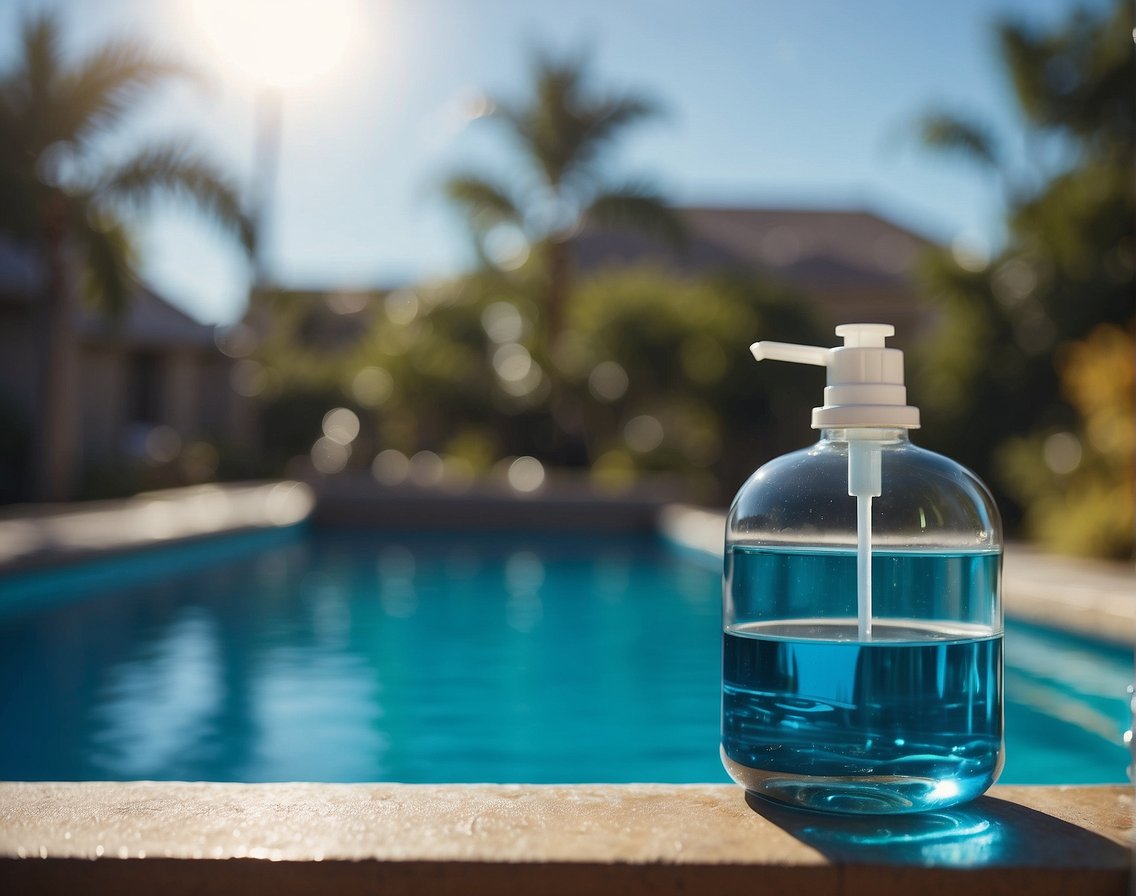
Maintaining chemical balance is crucial for a pool’s health and the safety of its users. We ensure that the water is clean, clear, and safe by regularly checking and adjusting the levels of various substances.
pH and Alkalinity Control
pH Level: The pH level is the measure of how acidic or alkaline the pool water is.
- Acidic water (low pH) can corrode pool equipment and cause discomfort to swimmers.
- Alkaline water (high pH) can lead to scaling and cloudy water.
To adjust pH levels, pool owners can use:
- pH increaser: Raises pH levels, typically contains sodium carbonate.
- pH decreaser: Lowers pH levels, commonly contains muriatic acid or sodium bisulfate.
Total Alkalinity: It acts as a buffer for the pH level, helping to stabilize it.
- Ideal Range: 80-120 ppm.
- If total alkalinity is too low, pH levels can fluctuate rapidly.
- If too high, it can resist pH adjustments and lead to scaling.
Alkalinity can be adjusted with alkaline materials such as sodium bicarbonate for increasing and acid for decreasing.
Calcium’s Impact on Water Quality
Calcium Hardness: Refers to the amount of dissolved calcium in the water.
- Proper Levels: 200-400 ppm for most pools.
- Low calcium hardness can damage pool finishes and equipment.
- High calcium hardness can cause scaling and scaly deposits.
Calcium levels are adjusted with:
- Calcium chloride: To increase calcium hardness.
- Dilution with fresh water: To decrease calcium.
Total Dissolved Solids (TDS): High levels can affect water clarity and balance.
- Pool owners should monitor and keep TDS levels within recommended limits.
Pool Water Stabilization Strategies
Cyanuric Acid: A stabilizer that protects chlorine from degradation due to sunlight.
- Ideal Cyanuric Acid Level: 30-50 ppm.
- Absent or low levels result in rapid chlorine loss.
- High levels can reduce chlorine efficacy and may require partial water replacement.
The strategy for stabilization includes:
- Regular testing of stabilizer levels using water testing kits.
- Adding cyanuric acid as needed, being careful not to exceed recommended levels.
Langelier Saturation Index (LSI): We use this to assess pool water balance, considering factors such as pH, alkalinity, and calcium hardness.
- An LSI near zero indicates well-balanced water.
- Negative LSI values indicate corrosive water.
- Positive LSI values signify scaling potential.
By regularly applying these strategies, we ensure pool water remains healthy and enjoyable for all swimmers.
Preventing and Resolving Common Pool Issues
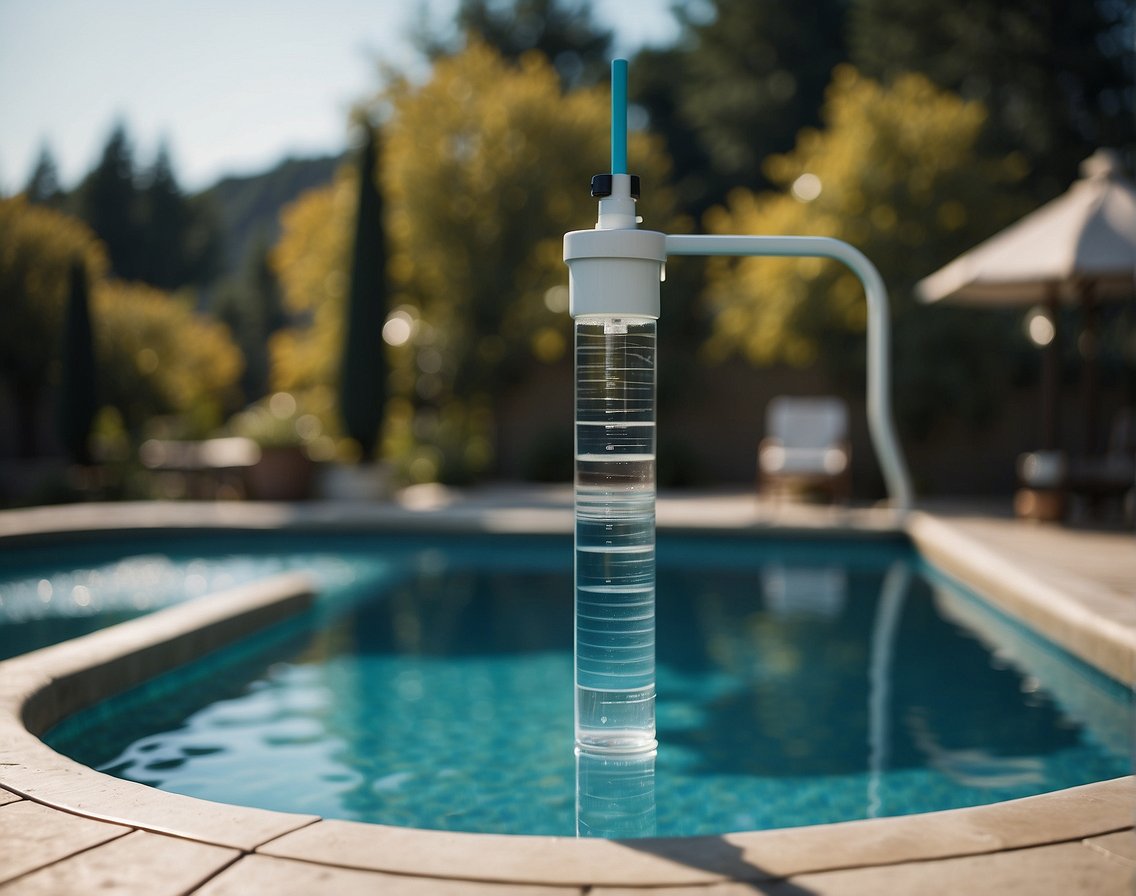
Maintaining a balanced pool is crucial for ensuring safe swimming and crystal-clear water. We’ll cover the prevention and treatment of algae, addressing water clarity issues, and combating common contaminants and irritants.
Algae Prevention and Treatment
To prevent algae growth, it’s essential to maintain the pool water chemistry within the appropriate pH range, which is typically between 7.2 and 7.8. This is where pH scale knowledge becomes practical. Regularly adding an algaecide as part of your maintenance routine can also deter algae from proliferating. In the event of an algae outbreak, you may need to shock the pool and increase the dosage of algaecide to regain control. For severe cases, brushing pool surfaces and employing a flocculant can assist in gathering algae for removal.
Addressing Water Clarity Problems
A cloudy pool is often a sign of imbalanced pool water chemistry. To achieve a crystal clear pool, it’s imperative to test and adjust chemical levels, especially after heavy pool use or significant weather events. Using a clarifier can help coagulate fine particles, making them easier to filter out. If the pool remains hazy, a flocculant might be necessary to clump particles together, which then settle to the bottom for vacuuming.
Combating Contaminants and Irritants
Pools can harbor various contaminants, including dirt, viruses, and bacteria, which can cause skin and eye irritation. To tackle these issues, it’s crucial to maintain an appropriate chlorine level, as it’s highly effective against these pollutants. For those opting for chlorine alternatives, biguanide can be an effective sanitizing agent. Regular shocking of the pool also plays a vital role in disinfection, ensuring all swimmers enjoy a safe and irritant-free experience.
Advanced Pool Maintenance Techniques
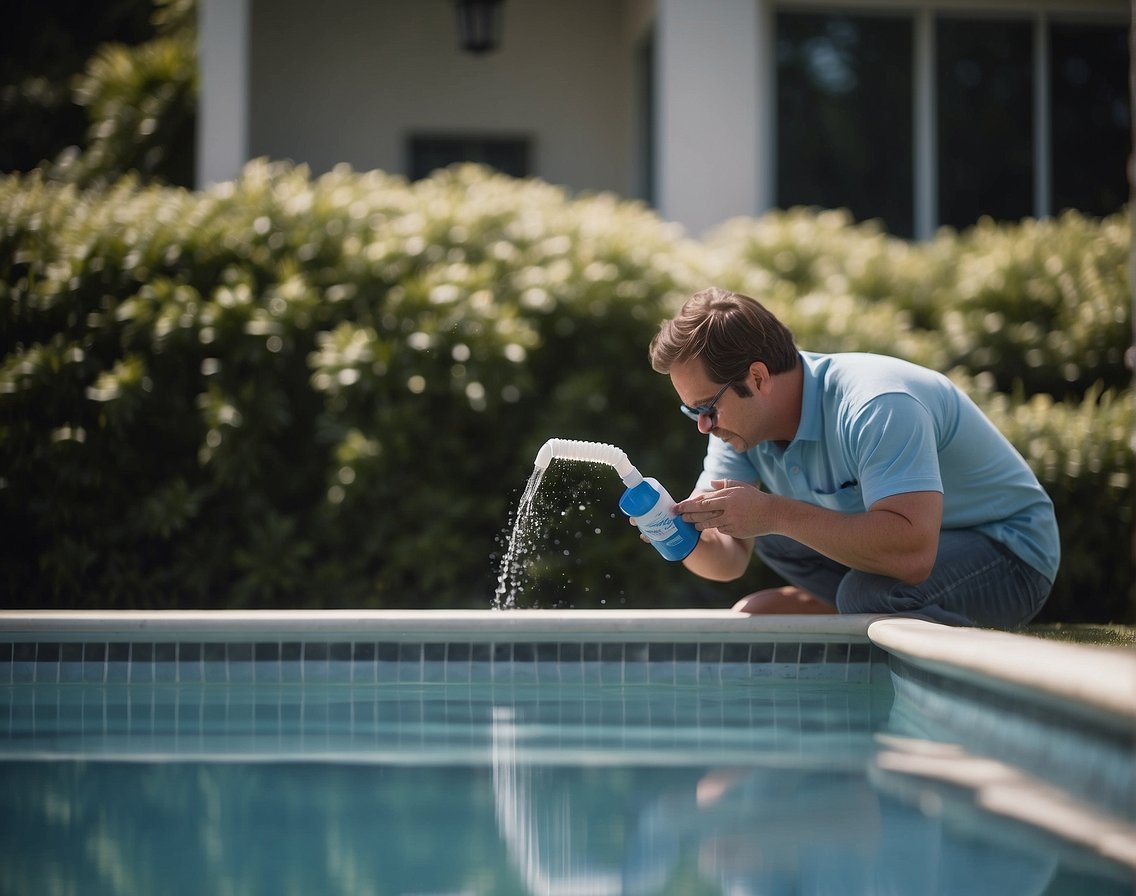
Maintaining the perfect balance in pool chemistry is crucial to ensure clear water and longevity of pool equipment. We must frequently assess and adjust chemical levels to keep pools safe for all swimmers.
Role of Shocking in Pool Care
Shocking a pool is pivotal to preventing algae and bacteria growth. As pool owners, we utilize shock treatments to drastically raise chlorine levels for a short period. Superchlorination is a technique where we add a large dose of chlorine to the pool water to break down contaminants and chloramines, which cannot be achieved by normal chlorination. To adequately shock your pool, we recommend following these steps:
- Test the pool water to determine the free chlorine level.
- Based on the water test results, calculate the necessary amount of shock product.
- Add the shock treatment during the evening to prevent UV rays from diminishing chlorine potency.
- Circulate the water to disperse the chlorine evenly.
- Re-test the water after 24 hours to ensure proper chlorine levels.
Seasonal Maintenance and Pool Equipment
With changing seasons come different maintenance needs, especially for outdoor pools. In the spring opening and autumn closing of a pool, we concentrate on specific tasks:
Spring:
- Inspect all pool equipment for any winter damages.
- Reinstall any removed parts like ladders or diving boards.
- Gradually restore water levels using fresh water.
- Balance the water chemistry by adding necessary chemicals, for example, soda ash to elevate pH or muriatic acid to reduce it.
Autumn:
- Deep clean the pool and check for any repairs.
- Decrease the water level to prevent freezing issues.
- Disconnect and winterize pool equipment, ensuring it’s free from water to avoid damage.
- Secure a pool cover to protect against debris.
When we encounter complex pool chemistry issues, it may be best to consult with pool professionals for advice or services. Pool management is a continuous process, and engaging a pool professional can offer us peace of mind and ensure our pools remain in pristine condition throughout the year.
Routine Testing and Professional Consultation
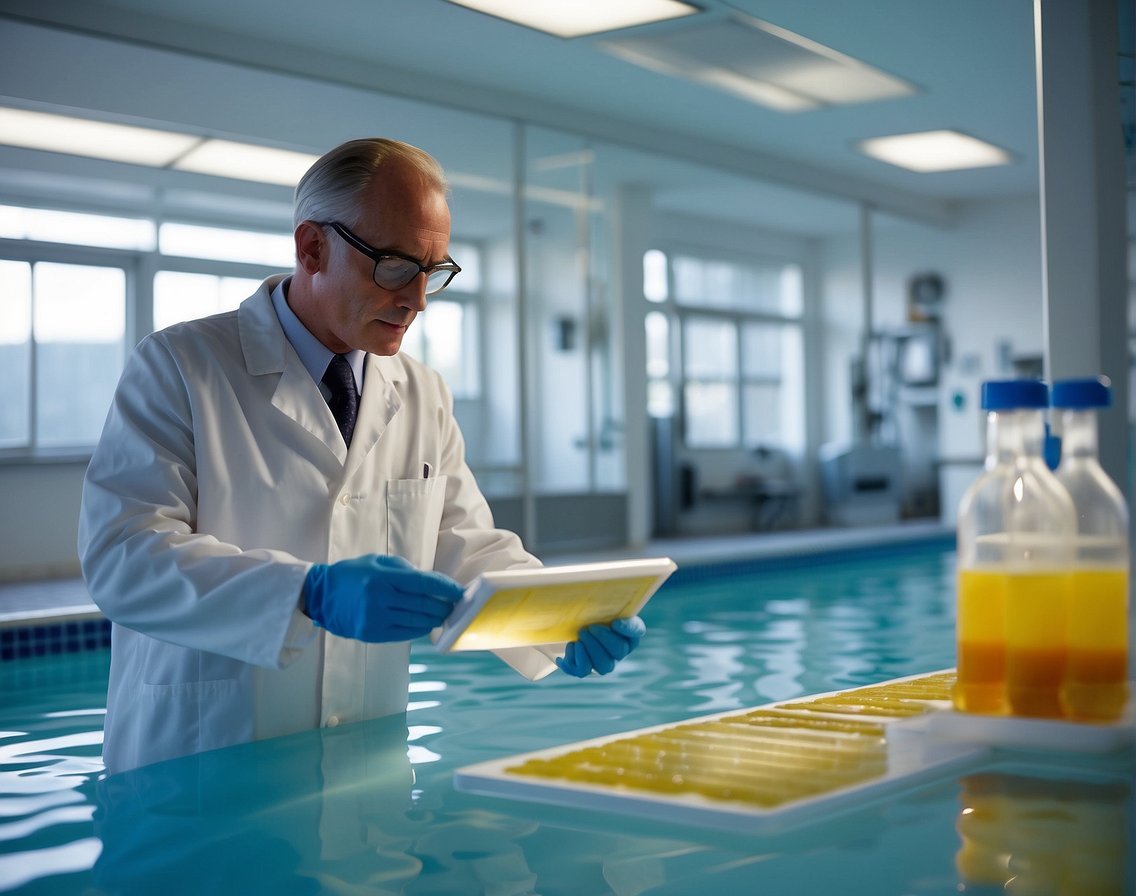
To ensure the safety and balance of our swimming pool, we adopt a combination of daily and weekly testing routines, supplemented with the expertise of pool professionals for more complex maintenance tasks.
Daily and Weekly Testing Routines
We perform daily checks on the pool’s chlorine and pH levels using a reliable pool testing kit. These testing kits often come with test strips that provide quick results:
- Test chlorine levels to ensure they remain between 1-3 ppm.
- Check pH levels, aiming for a range of 7.4 to 7.6.
Weekly, more thorough testing is conducted to examine additional components of the water balance:
- Total alkalinity: Maintained between 80-120 ppm as a buffer to stabilize pH levels.
- Calcium hardness: Ideally between 200-400 ppm to prevent plaster damage.
- Bromine levels: If used instead of chlorine, kept at 3-5 ppm.
- Temperature: Monitored as it affects chemical effectiveness.
- Metals: Adding a metal sequestrant weekly to bind metals and prevent staining.
Professional Pool Care Assistance
For in-depth pool maintenance, we trust professional pool care assistance. Pool professionals gauge the pool’s compliance with health code regulations and conduct a comprehensive evaluation:
- They take water samples for advanced analysis, far beyond what basic test strips can indicate.
- Address the nuanced needs of swimming pool chemistry, such as the effects of frequent usage and environmental factors.
- Recommend corrective actions, which may include shock treatments or changes to the routine chemical additions.
- Offer services involving treatment for the prevention of algae and calcium build-up, ensuring safe swimming conditions.
Scheduling regular consultations with pool professionals gives us peace of mind that our swimming pool remains safe and properly maintained for everyone’s enjoyment.
Frequently Asked Questions
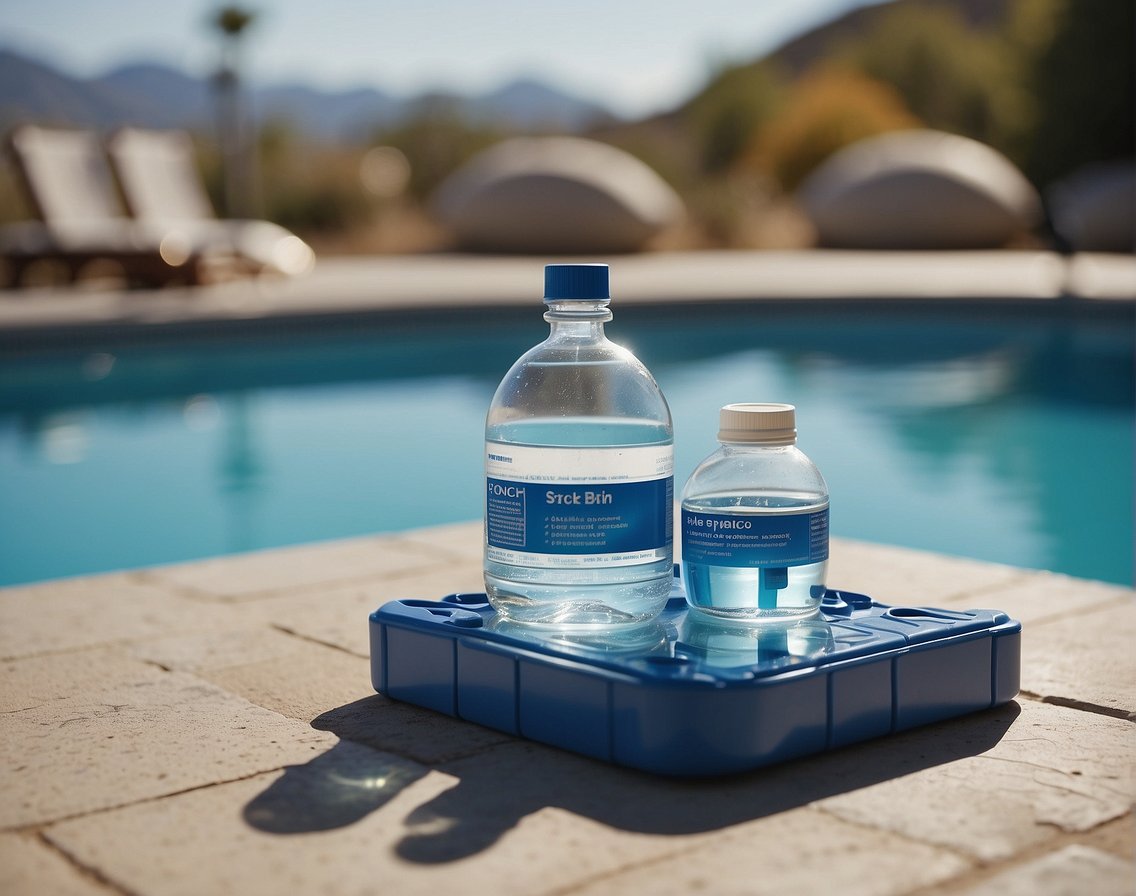
Proper pool chemical balance ensures the health and longevity of both the pool and its users. We’ll address key inquiries about maintaining this balance, with a particular emphasis on the role of chlorine.
What chemicals are essential for maintaining proper pool water balance?
To maintain proper pool water balance, we consider chlorine, pH adjusters (both increasers and decreasers), alkalinity adjusters, calcium hardness increasers, and stabilizers or conditioners essential. These chemicals work together to keep the pool water safe and comfortable for swimmers.
How does chlorine contribute to the overall chemical balance in a swimming pool?
Chlorine is a primary disinfectant responsible for sanitizing pool water. It eliminates bacteria, viruses, and algae by breaking down their cell walls, resulting in a clean swimming environment. By maintaining the proper chlorine levels, we prevent the proliferation of microorganisms and keep the water clear.
What steps should be taken to adjust pH levels before administering chlorine?
Before administering chlorine, we first test the water’s pH level to ensure it’s within the ideal range of 7.2 to 7.6. If it’s necessary to adjust the pH, we add a pH increaser or decreaser accordingly. It’s vital to balance the pH first because extreme pH levels can reduce the effectiveness of chlorine.
In which sequence should pool chemicals be added to ensure effective water balance?
We start with balancing the total alkalinity, followed by adjusting the pH. Once these levels are stable, we add chlorine. This sequence helps prevent chemical reactions that could affect chlorine’s efficacy and ensures the other chemicals perform optimally for maintaining overall water balance.
How can you effectively regulate the chlorine concentration in a pool?
We regulate the chlorine concentration in the pool by consistent monitoring and adjustment. Test the water regularly, ideally daily, and add chlorine as needed to maintain the recommended level of 1 – 3 ppm (parts per million). Automatic chlorine feeders or saltwater chlorine generators can also be used for consistent chlorine dosing.
What methods are recommended for balancing pool water chemistry after a complete refill?
After a complete pool refill, we first allow the fresh water to circulate for a few hours. Then, we test and adjust the total alkalinity, followed by pH, and finally, calcium hardness levels. Once these parameters are balanced, we add chlorine and other necessary chemicals to ensure the long-term chemical stability of the pool water.
